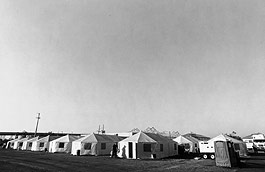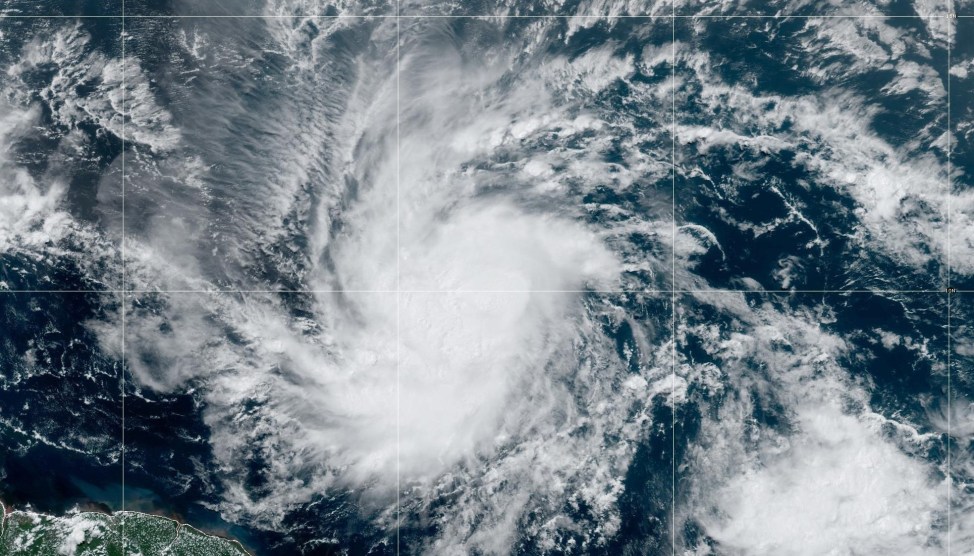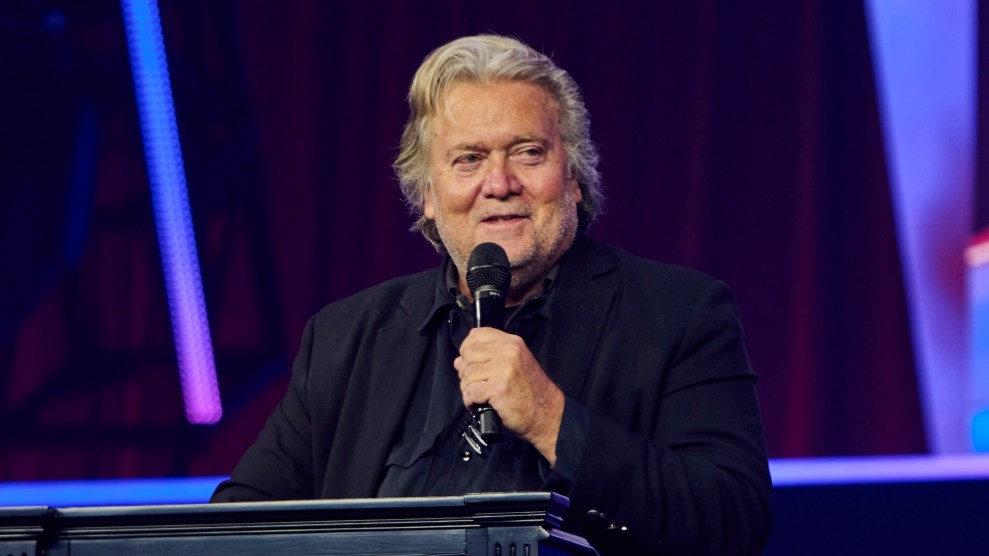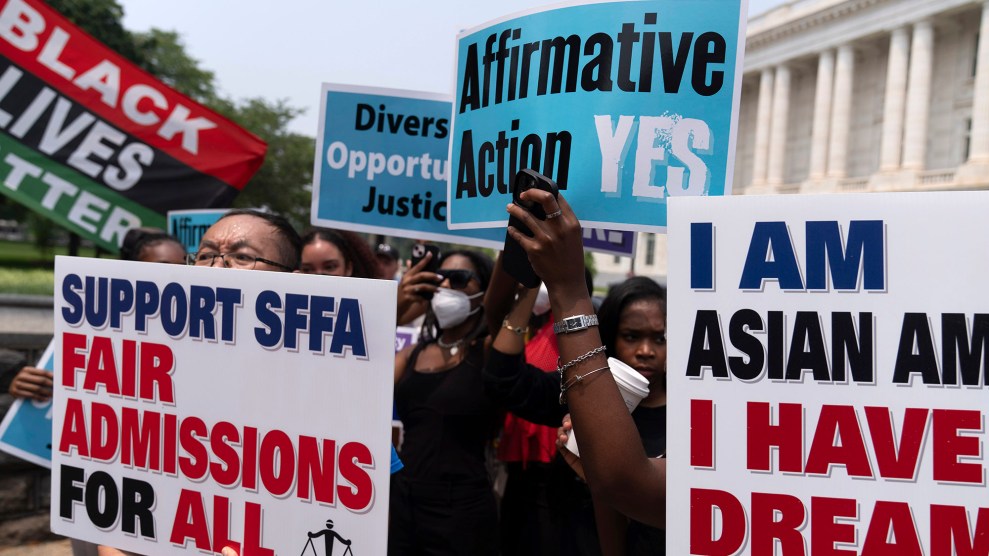
Photos: <a href="http://practice.motherjones.com/authors/kike-arnal">Kike Arnal</a>
NEW ORLEANS – In the days after Hurricane Katrina slammed into New Orleans, the city’s Algiers neighborhood was one of the few that stayed dry. Although Katrina’s winds caused extensive damage to roofs and toppled trees and power lines, there was no water in the streets or in houses like there was in the rest of the city. Still, Algiers was left without electric power or running water for many days, and the invasion of the city by thousands of soldiers, federal police officers and private paramilitary personnel created an atmosphere of tension and trepidation. In Algiers, as in other neighborhoods, the National Guard imposed a mandatory dawn-to-dusk curfew. In one area, white residents frightened by rumors of car-jackings and looting camped out on their roofs and organized patrols, guns at the ready. Late one night, National Guardsmen and a SWAT team from the New Orleans Police Department raided the Algiers Fischer Housing Development in search of someone who had fired at a cell phone truck; black youths then took guns from local pawn shops and vowed to fight the troops and what they called white vigilantes. Algiers resident Ronald Ragens, 55, remembers those days as lonely and frightening. “All you was seein’ was police, military and all kinds of huge trucks running supplies here and there, and helicopters flyin’ over like it was a war zone,” he recalls. “It was rough.”
Then one morning four days into the storm, something happened that melted the fear and eased the tension. Four young people on bicycles showed up in Algiers, knocking on doors and asking if anyone needed medical attention. Asked if they were from the Red Cross or the Federal Emergency Management Agency, neither of which had yet made an appearance in Algiers, the medics said no, they were just volunteers who had come without authorization. They offered first aid, took blood pressure, tested for diabetes, and inquired about symptoms of anxiety, depression and disease. “It was just about the noblest thing I’ve ever witnessed in my life,” recalls Malik Rahim, a lifelong Algiers resident, local housing activist and former Black Panther Party member who helped arrange space for the medical workers in a local mosque. ”It was the street medics who really stopped this city from exploding into a race war, because they were white and were serving the black community at a time when blacks were fed up. Those are the real heroes of this thing.”
 As New Orleans moved from tension and fear to FEMA tents, the Common Ground Clinic took over the task of providing local health care from devastated hospitals.
As New Orleans moved from tension and fear to FEMA tents, the Common Ground Clinic took over the task of providing local health care from devastated hospitals.Rahim, a friendly, outgoing man whose graying dreadlocks and soft voice belie his radical past, is now the symbolic leader of the Common Ground Collective, an unlikely tribe of activists and health care practitioners who have descended on New Orleans to provide “solidarity, not charity” to the people of this devastated community. The “street medics” on their bikes–part of a loose national network of nurses and medical assistants who provide first aid to protesters at antiwar demonstrations—were among the first to respond. “The whole place smelled like death,” recalls Noah Morris, a wiry anti-corporate activist from St. Louis who recalls seeing four gunshot victims, their bodies crudely covered by sheets of corrugated tin. Most of his initial patients, Noah says, suffered from high blood pressure, which he treated with herbal remedies and nutritional supplements “to help get the pressure down just a little bit.” The medics were followed a few days later by a caravan of doctors, nurses and grief counselors from San Francisco. Then, as word of the clinic spread, scores of health practitioners and political activists from all over the country began making their way to New Orleans.
Common Ground has drawn an eclectic crew. Michael Kozart, the first doctor to spend substantial time at the clinic, belongs to a group called the Bay Area Radical Health Collective. He decided to come after hearing Rahim speak about Algiers on KPFA, the Pacifica affiliate in Berkeley. “I thought, how can a society as rich as ours have folks being neglected because our water and medical system and the government itself is completely inefficient?” Liz Rantz, another doctor, has spent two stints here on leave from her regular job in Missoula, Montana, where’s she’s the medical director for the state’s Department of Corrections. The California Nurses Association has sent a steady stream of RNs. Acupuncturists Without Borders has organized several teams of volunteers. Volunteers have come from Minnesota, Massachusetts, Iowa, Texas, New Mexico and Canada; during the first week, there were two French volunteers from Doctors Without Borders. From the triage station to the makeshift pharmacy, there are plenty of nose rings, dreadlocks and body jewelry on display – as well as the cleanly pressed uniforms of nurses fresh from their hospital jobs.
“I was completely unaware they were a bunch of activists,” says Lynne Crawford, a bubbly nurse from Harrisburg, Pennsylvania, who spends most of her time working at the mobile clinics. Crawford, who wore her blue scrubs while doing her rounds, found her way here after being laid off from her last job ; after searching for ways to volunteer, she discovered Common Ground on the Internet. Unlike many of her colleagues, who sleep on the clinic’s floor or in camping tents set up in the backyard, Crawford managed to find a room on a Coast Guard cutter docked in New Orleans. When I ran into her one afternoon, she confesses to having suffered “a very big cultural shock” in her first days at Common Ground. She pointed to some of her new friends, clustered outside on a smoke break: “Why don’t they shave their legs? I just don’t get it,” she said, laughing. “But now I love the people here. We all have a common purpose.”

For activists accustomed to being marginal, Common Ground has been a revelation too. “How many political actions do you have when all of a sudden the community kind of descends on you?” asks Scott Weinstein, a tall, bearded RN from Washington, D.C., who was one of the first arrivals and serves as a liaison with what’s left of the New Orleans medical community. He says the clinic has reshaped the way he thinks about politics. “Most people think of direct action as taking a street during a demonstration,” he says, “but big deal, so you got a street. This is not about taking the streets, it’s about taking health care.”
THE MAJID BILAL MOSQUE sits on a busy street corner three blocks down from the levee. There, just past a warehouse storing colorful floats from past Mardi Gras, you can see the city’s skyline, the Superdome and the two Carnival Cruise ships – the Sensation and the Ecstasy – that were leased by the federal government for nearly $200 million to house emergency workers. Big tugs and ocean-going tankers and container ships pass by in a steady stream. The clinic itself is surrounded by tiny, one-story houses, most of their roofs patched with blue plastic tarps. A sign on the building’s back door reads: “No Weapons Allowed. Please Respect the Mosque” – a reference to the ubiquitous guns toted by the National Guard and private security guards at every government facility in the city. When the clinic opens for business one October morning at 8:30 a.m., the waiting room immediately fills up with patients.
Andrew Summer, a laid-off shipyard worker living in nearby Gretna with his brother, is here to get his medications refilled – still, months after the storm, the most common need among Common Ground’s patients. Summer is tall, lanky, and visibly tired. He survived Katrina in the Lower Ninth Ward, was brought by boat to the Convention Center, and eventually flown to Houston. He can’t fill his prescriptions because Charity Hospital, the famed hospital that once served most of New Orleans’s poor, has been shut down. “It’s great how they’re handling the people here,” he says.
Taking in the scene from his stoop a few doors down is Leroy Refuge, 53, a lifetime New Orleans resident who used to drive a school bus for the local diocese. He and a companion he is caring for (“her name is Miss Dorothy L. Brown, and she’s 78 years old”) have both visited the clinic and got shots “to keep the germs and everything away.” Refuge, too, was evacuated from Algiers; he ended up at Kelly Air Force Base in Texas before being flown home three weeks later. “Now we’re back at 329 Socrates and just tryin’ to live,” he says. “My mind is still a little fuzzy, but I’m comin’ around – slowly but surely, slowly but surely.” For many of Common Ground’s patients, the clinic is a relief not just from Katrina and the healthcare vacuum that followed—suddenly there were no doctors or hospitals in New Orleans, and neither the Red Cross nor FEMA seemed able to provide any—but from a quieter, long-term emergency. According to Rahim, 85 percent of the men in Algiers are uninsured, “and for many of them, the last time they saw a doctor was in prison or in emergency at Charity.”
Common Ground has found itself serving some unexpected needs too. During its first month, its medical teams gave immunizations to hundreds of laborers employed by subcontractors for the likes of Shaw Inc. and Halliburton—companies that left their workers, many of them Latino immigrants, to figure out for themselves which shots they needed and where to get them. When Rita flooded hundreds of square miles in the bayou town around Houma, Louisiana, Common Ground fielded the only relief team to visit the area; neither the Red Cross or FEMA ever made it, according to Dr. Rantz and three other volunteers who went.
MOST OF COMMON GROUND’S medical work happens at three crude work stations in what used to be the mosque’s worship hall. Station One is a card table with makeshift shelves holding cotton swabs, rubber gloves and other equipment; a stethoscope hangs over the one corner. Station Two consists of a pair of stools standing next to a set of shelves that looks like it came from a motel room. Stacked neatly are some of the donated supplies the clinic is handing out: Tampax, witch hazel, Enfamil formula, calcium supplement. Station Three is the only “private” room in the clinic, partitioned from other stations with bedsheets. After a brief intake from a triage volunteer, patients wait their turn in the line of chairs that serves as a waiting room; when their name is called, they head for one of the stations, where a nurse practitioner takes their vitals and consults with one of the doctors about what to do.

In the adjoining room, past the busy phone and fax machine, is a crude pharmacy stocked with supplies that have been donated from organizations like Vets for Peace and Food Not Bombs. At the back is a bank of computers linked to the Internet through a sporadic wireless connection provided by FEMA from the cruise ships across the river. On one wall are lists of important projects and tasks that need volunteers, including “critical incident debriefing” and “medical legal support,” under which someone has scrawled “or covering our heinies.” One task is more general: “Infusing all we do with anti-oppression intentions.”
Although hierarchy is frowned on here, some people at Common Ground clearly play leadership roles. One of them is Moe, an RN and herbalist from Montana who has been here since early September. She is often one of the first to greet newcomers and the person to find when there’s a problem with no ready solution. Moe is short, with a moon-shaped face that seems to be framed in a perpetual smile. Like Noah, she’s part of the street medic network that descends on cities like Seattle or Washington, D.C., whenever there’s a big demonstration. She is gentle, low-key, and pragmatic. In late November, it was Moe who pushed hard to get the clinic to close every Friday so volunteers could take a break. “We couldn’t get anything done” for the stress, she tells me.
For the people working here, Common Ground is the polar opposite to the time-crunched, profit-driven, top-down environment that’s become standard in the health care industry. When the clinic crew learns that a patient is bedridden and can’t get out of the house, someone drives there to pick her up and then arranges for transportation back home. The same doctor might make a diagnosis, write a prescription and go to the back room to fill it. One day, Max Fischer, who’s in his fourth year of medical school at Columbia University, sees 10 patients in 15 hours—a fraction of the load he’d handle at a hospital or regular clinic. One is a 19-year old mother with an advanced bone infection in her leg; with Charity closed, she had no idea where to find a doctor. Max calls for an ambulance to take the woman to West Jefferson Hospital in Gretna—and rides along with her when it comes. “I see myself as a patient-advocate,” says Fischer.
Alternative styles of medicine are big at Common Ground. “In those moments, in that half an hour I’m talking to someone, it’s just love that I feel,” says Marenka Cerny, a trauma counselor and massage therapist from Oakland who has set up a table just outside the clinic. Every day I’m there she has a steady stream of customers, who approach her shyly but get up from her table looking relieved. “We’re providing human contact, the most basic thing you can do for people facing so much devastation and loss,” she says. Next to her table, Korben Perry, an acupuncturist from Philadelphia, has put out a couple of chairs and a sign. One afternoon I find him working on Willy Kerr, who says he’s been coming to the clinic ever since he got back to Algiers from Houston, where he was evacuated after the storm. He’s never seen Chinese medicine before, but Perry persuades him the needle treatment will help relieve the pain in his back and gums. “I’m trying to stop smoking,” Kerr confides. As Perry places needles in his earlobes and neck, Kerr chuckles, and then settles down for a 20-minute wait. “These people here are treating me real nice,” he says. “I’d hate to see them go.” Like many others in this neighborhood, Kerr, who worked until recently at a Murphy Oil refinery south of New Orleans, is convinced that the Ninth Ward didn’t flood by chance. “They blew them levees,” he tells me. “You make sure you write that down.”
Later that afternoon, two camouflaged US Army trucks pull up outside the mosque. As their engines idle noisily, a young lieutenant jumps out, identifies himself as Louisiana National Guard, and announces that he has several boxes of supplies for the clinic. Moe, who spends much of her time organizing donated supplies of dubious utility, smiles widely when she sees the packets of cortisone and the children’s antibiotic Zithromax. For the next 15 minutes, soldiers just back from Iraq and a couple of anarchists who’ve been protesting the war unload the truck together, swapping anecdotes about New Orleans and the French Quarter.
UNLIKE SOME OF THE volunteers, who camp out in the mosque and surrounding houses, during my stay in New Orleans I crash with other medical workers at Tent City, a FEMA campsite in Algiers. In the mess tent, you see everyone who has a piece of rebuilding and securing New Orleans: National Guard troops, their rifles leaning on the tables; exhausted workers from the water and sewer company; tough-looking New Orleans cops; and the uniformed private guards from Blackwater. It’s a disconcerting place, full of short fuses and weapons, much like anyplace else in post-Katrina New Orleans–which is part of what makes Common Ground such an oddity.
By late October, all of the city is dry and relief workers as well as residents are beginning to venture into the Ninth Ward. Common Ground has set up a distribution center in a former day car center there, handing out donations from groups as varied as Pastors for Peace, which sent several box loads of boots, and the Islamic Relief Fund, which has provided 50 large buckets of “cleaning supplies”—each one marked with the logo of the Church of Jesus Christ of Latter Day Saints—containing masks, sponges, spray bottles, gloves and hand cleaner. Several times a week it sends a medical crew to the Disaster Recovery Center in the Lower Ninth Ward, a parking lot where FEMA has set up an information table for returning residents.
At the FEMA site, guns are everywhere; on the shoulders of the National Guard troops guarding the site and in the holsters of New Orleans cops and the Immigration and Customs Enforcement officers from the Department of Homeland Security. FEMA has hired four Blackwater guards for its own table; they stand around wearing identical logo’ed black shirts and identical wrap-around sunglasses.
Around them, the neighborhood is utterly destroyed. Electric and telephone wires are down; vehicles lie at crazy angles, some of them stuck in fences and walls and buried in living rooms. The streets and sidewalks are caked with mud that has calcified where it flowed into open doors. There’s a silence that feels all wrong in a city neighborhood, broken only occasionally by the crunching sound of tires on the dry mud.
By contrast, Common Ground, despite its chaos and occasional dysfunction, feels almost light-hearted. By the time I visit again in December a steady stream of people from the neighborhood, (including Willy Kerr, the acupuncture patient), are signing up to volunteer. A lifelong Algiers resident, Sandra, is now working as the clinic’s cook, doling out helpings of gumbo and bread pudding. A community advisory board is being set up, and the clinic is eyeing a larger site down the street. “That clinic is gonna be a permanent clinic,” Malik Rahim tells me, “served by the people its serving right now.”












